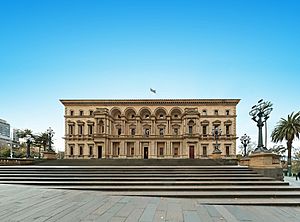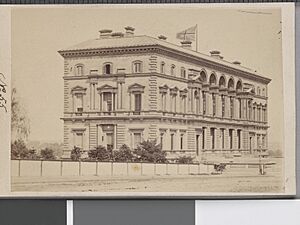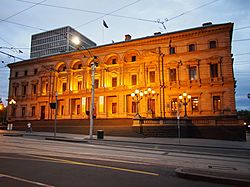Old Treasury Building, Melbourne facts for kids
Quick facts for kids Old Treasury Building |
|
|---|---|

Old Treasury Building
|
|
| General information | |
| Status | Complete |
| Type | Public |
| Architectural style | Renaissance Revival |
| Location | Victoria |
| Address | 20 Spring Street, East Melbourne |
| Country | Australia |
| Coordinates | 37°48′47″S 144°58′27″E / 37.813153°S 144.974121°E |
| Construction started | 1858 |
| Completed | 1862 |
| Owner | Victoria State Government |
| Design and construction | |
| Architect | John James Clark |
|
Australian National Heritage List
|
|
| Official name | Old Treasury Building |
| Type | Historic |
| Designated | March 21, 1978 |
| Reference no. | 5210 |
| Official name | Treasury Reserve Precinct |
| Type | State Registered Place |
| Designated | 20 August 1982 |
| Reference no. | H1526 |
| Heritage Overlay number | HO174 |
The Old Treasury Building on Spring Street in Melbourne was built in 1858-62 in the grand Renaissance Revival style. It was designed to accommodate the Treasury Department, various government officials' offices including the Governor In Council, and basement vaults intended to house gold from the Victorian gold rush. It now houses a range of functions, including a museum of Melbourne history, known as Old Treasury Building Museum.
History
The Treasury Building was constructed between 1858–62, and is considered one of Australia's finest Renaissance Revival buildings. One original purpose was to house some of the bullion from the gold rush in the 'gold vaults' in the basement, but by the time it was finished the rush was over, and they were used to store government documents instead. The main purpose was to house offices for the Treasury Department, along with rooms for the Chief Secretary, the Treasurer, the Registrar-General, the Registrar of the Supreme Court, and the Auditor General, as well as one for the Governor of Victoria when he was on government business.
The building was designed by young architect J. J. Clark who was just 19 years of age in 1857. The design developed over the next two years, and many of J J Clark's drawings are on display throughout the building. Architectural historian Miles Lewis once described The Old Treasury as the "finest public building exterior in Australia". Clark had already designed a few government buildings, including the Printing Office located behind the Treasury building, and later went on to design many government buildings both in Victoria and elsewhere, notably the Old Mint in Melbourne, considered to be another fine example in a classical style, and the grand Brisbane Treasury in Queensland.
While the building itself was completed in 1862, there was long delay in completing the forecourt, with individual timber staircases leading to the three main front doors. In 1868 these were replaced with the grand forecourt and cast iron lamps still standing today.
It is the cornerstone of the Treasury Reserve government precinct adjacent to the Treasury Gardens and creates an important vista terminating Collins Street, the financial spine of the city.
When the official treasury offices were moved next door to 2 Treasury Place in 1877-78, the building was nicknamed the 'Old Treasury'.
As a leading public building in Melbourne, located in a prominent position with open space around it, the Old Treasury has been the focus for many celebrations and major public events. The arrivals and departures of the Governors of Victoria were occasions for expressions of loyalty to the Crown and sometimes for political statements. In recent years it has been the destination for the Grand Final parade of AFL footballers.
The building is also notable for its role when Melbourne was the temporary capital city of Australia after Federation, with the National Executive Council meeting there. Previously in February 1899, a "secret" Premiers' conference was convened, when it was decided Melbourne's Parliament House would be the temporary capital until the location of the Australian National Capital was officially decided.
Establishment of a museum
During the 1970s, the Dick Hamer Government was developing policy for museums in Victoria. In 1981, Hamer's Arts Minister, the Hon. Norman Lacy, established a Museums Development Committee to develop a comprehensive museums policy for Victoria.[1] He then also proposed to the Executive Committee of Victoria's 150th Anniversary Celebrations in 1984 that a new Museum of Social and Political History be established at the Old Treasury Building. [2]
Finally in 1994 after restoration of the building, the Old Treasury Building Museum was opened with exhibitions detailing the history of Melbourne, the Victorian gold rush, and the history of the building. Operations of the buildings and the museum are vested in an Old Treasury Building Reserve Committee of Management, and is a registered charity. The Museum has changed name a number of times, becoming the Gold Treasury Museum, the City Museum at Old Treasury and then the Old Treasury Building Museum again. Since 2011 it has presented programs in partnership with Public Record Office Victoria (PROV).
In the media
The Old Treasury Building has been used as a filming location. It features in the climactic sequence of the film Knowing (2009), a film set in Boston, Massachusetts. Melbourne and Boston are officially recognised as being sister cities.
Occupants
The Old Treasury was built to house the Treasury Department and store gold, but also provided offices for the leaders of the young colony, including the Governor, the Premier (at the time called Chief Secretary), the Treasurer, the Registrar-General, the Registrar of the Supreme Court and the Auditor General. Since its construction in 1862, it has also held the office of His Excellency the Governor of Victoria, who still holds weekly meetings of the Executive Council, consisting of the Governor and at least two Ministers of the Crown, that is, the leaders of the governing party. The Governor in Council as this meeting is called, is the formal enacting of legislation when the Governor's signature and the Great Seal of Victoria is put in place on the bill. Various other appointments and other regulations are also formally made at this weekly meeting, upon the advice of the Premier and Parliament of Victoria.
In addition to the museum, the Old Treasury Building is now home to the Office of the Victorian Government Architect, The Victorian Marriage Registry, and offices for most living former Premiers of Victoria.
See also
- Architecture of Melbourne
- List of heritage-listed buildings in Melbourne
- Victorian architecture




